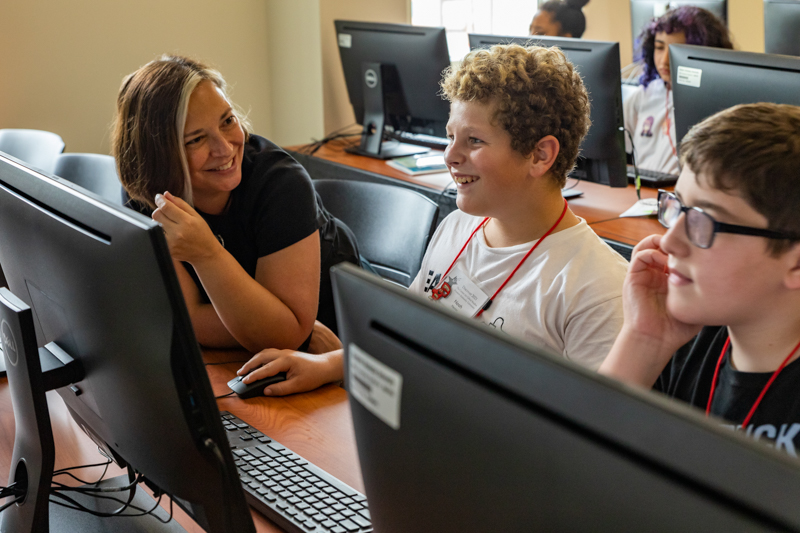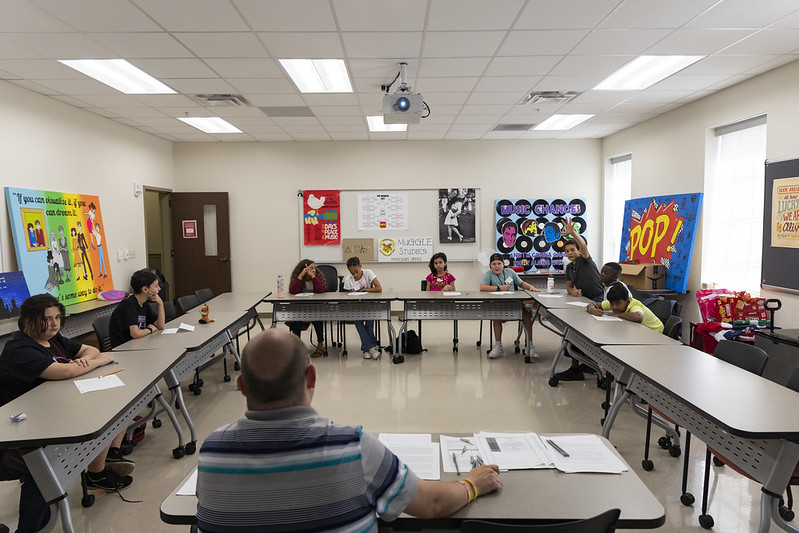by Erika Solberg
On Thursday in Coding: Create Your Own Video Game, teacher Jennifer Sheffield helped students finish coding their interactive creations using Scratch, a free programming language that uses block-coding. Students combine the blocks in combinations from simple to complex to create interactive stories, games, and animation. Using Scratch has allowed Jennifer to tailor the course to a wide range of coding experience among her students and to provide ample choice for what projects to work on.
Christopher Nalley was coding a Cat-and-Mouse-style game where an elf chases an apple in different settings. He explained, “You press the arrow keys to move. There are three levels, a first level where the apple moves at a slow speed up to the third level where it moves extremely fast.”
Kinsley Board was working on animating a bear. “It’s walking too slowly,” she noted. Earlier in the week she coded a project where a bunch of people on the screen danced to Michael Jackson’s “Rock with You.” She likes coding because “You can make whatever you want.”
Divine Ezinma was coding a song player, having finished some animation projects earlier. Liam Meredith was working on an interactive story; he had already made a Ping-Pong-style game and a flying game where the player scores points by catching balloons.
Hayden Boone was coding a baseball game with a pitcher, batter, and catcher. He explained, “Everything goes into motion on my commands — the space bar controls the pitcher, and the right arrow controls the batter. I like that in coding, you’re able to control everything. I don’t get some of it yet, but I’ll learn!”
Maddy Blakely was coding a game where the player catches fish and other objects for some points, and she was working on getting a crystal to look just right. Coding appeals to her because “You can let your imagination go wild.”
Meanwhile, Jennifer and a few students who had finished their coding projects were experimenting with Makey Makey, a computer hardware invention kit that can make a keyboard out of anything conductive using closed and open circuits. By attaching circuit tracers, one student could touch another student’s arm to make a sound — a dog’s “Woof!” was a popular choice. They could also turn a graphite pencil drawing into a keyboard using the circuit tracers, and Jennifer also showed them how they could put tracers into a piece of Play-doh to make a squishy game controller.
***
At the trial of Goldilocks on Friday morning, there was quiet in the courtroom. It was the first period of Think Like a Lawyer, and teacher Justin Mitchell wore robes as he sat at the front of the classroom with a table top tilted up in front of him to look like a judge’s bench. Lawyers for the prosecution and defense sat on opposite sides in the room, all wearing ties, and witnesses waited their turn in the back.
Currently, Papa Bear (depicted by Eliza Lewis) was finishing up his turn on the stand, furry arms and claws (attached to a vest that served as the costume, in turn, for each member of the Bear family) resting on the table in front of him.
“Did you purposely scare off Goldilocks?” asked prosecution lawyer Mattie McPherson.
“No,” replied Papa Bear.
The witness was excused, and bailiff Sypher Appling swore in the next witness, Mama Bear (Des Maxey). He told her, “Please raise your right hand — er, paw.”
Then defense lawyer Max Isenhower grilled Mama Bear about the events of the morning in question. “When did you finish making porridge?” he asked.
“Nine,” she promptly answered.
“Why did you leave the door unlocked?”
“We were not going to be gone for long.”
During the questioning, Judge Justin reminded both legal teams that they could raise objections using any of the grounds listed in their class packet, and soon Kenny Chen of the defense objected to Max’s question about whether or not Baby Bear liked to cry in his bed. “It’s immaterial,” he said.
“Overruled,” Judge Justin responded. “Though an objections on other grounds might have worked.”
This class was the culmination of a week of using the same critical thinking strategies found in law schools to analyze real life cases, such as Baughman v. Walt Disney World, where a park visitor with a disability sued for the right to use a Segway at the park, and Coomer v. Kansas City Royals, where a spectator was injured when he was hit in the eye with a hotdog thrown by the team mascot. Students have learned not only about the law but about effective argument techniques, such as respectful listening and searching for common ground.
Back in the courtroom, defense lawyer Max approached a new witness slowly, one arm behind his back. “Baby Bear,” he asked. “Why didn’t you lock the door?”
“I’m five,” the witness (Eliza Lewis) answered a bit petulantly.
The judge advised the witness to “lose the attitude.”
“Why did you scream?” Max questioned.
“I didn’t expect to see someone in my bed,” Baby Bear answered.
The defense team then called for a moment to consult with each other, and around the room students whispered intently. It may have been a mock trial, but the enthusiasm and the learning were real.
*dun-dun*


